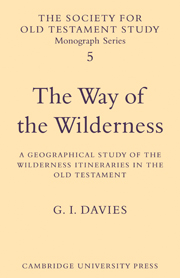Book contents
- Frontmatter
- Contents
- Preface
- Abbreviations
- Maps
- 1 Introduction
- 2 Jewish interpretations in Greek
- 3 Jewish interpretations in Hebrew and Aramaic
- 4 Christian interpretations
- 5 Arabic interpretations
- 6 Behind the traditions
- 7 Key points on the routes
- 8 Routes in the Sinai Peninsula
- 9 Identification of the routes described
- Notes to the text
- Bibliography and Author Index
- Indexes
5 - Arabic interpretations
Published online by Cambridge University Press: 04 August 2010
- Frontmatter
- Contents
- Preface
- Abbreviations
- Maps
- 1 Introduction
- 2 Jewish interpretations in Greek
- 3 Jewish interpretations in Hebrew and Aramaic
- 4 Christian interpretations
- 5 Arabic interpretations
- 6 Behind the traditions
- 7 Key points on the routes
- 8 Routes in the Sinai Peninsula
- 9 Identification of the routes described
- Notes to the text
- Bibliography and Author Index
- Indexes
Summary
Old Testament scholars have generally paid far less attention to Arabic geographical traditions than to those of Jews and Christians in trying to determine the route of the wilderness journeys. This is not surprising when the late date at which they are attested is remembered. Moreover, if the survey that follows (which is based only on what is conveniently available in the selections translated by Le Strange and Marmardji) gives a representative picture, there were remarkably few attempts to give a precise location to the places named in the Bible. Nevertheless, from the point of view of the history of interpretation this branch of the tradition is as important as any other.
The main exception to the general tendency of Old Testament scholars to neglect the Arabic evidence was A. von Gall. In the section on Sinai in his Altisraelitische Kultstätten, von Gall cited a number of passages from the classical Arab geographers which, he claimed, supported his view that Mount Sinai was east rather than west of the Gulf of Akaba. One of the tasks before us is to see whether von Gall has given an accurate picture of what Arab writers of the medieval period thought about the geography of the wanderings.
An appropriate starting-point is the definition of the area associated with the wilderness wanderings as a whole.
- Type
- Chapter
- Information
- The Way of the WildernessA Geographical Study of the Wilderness Itineraries in the Old Testament, pp. 49 - 55Publisher: Cambridge University PressPrint publication year: 1979



